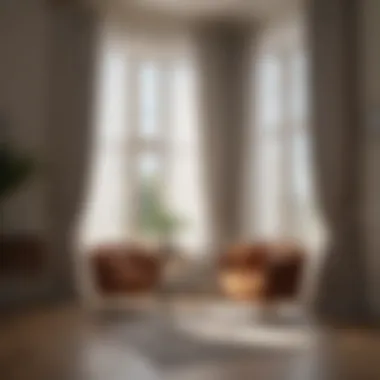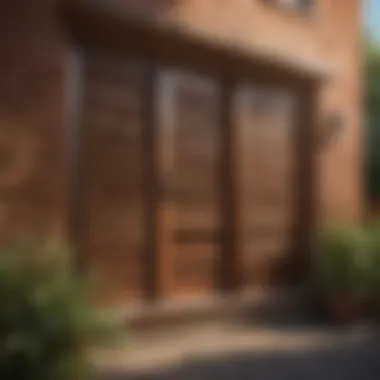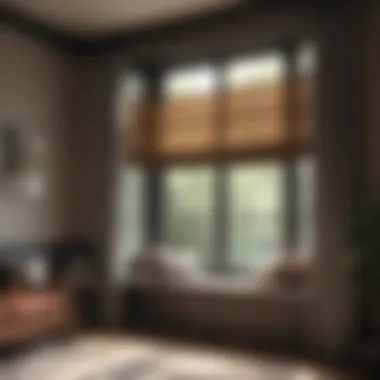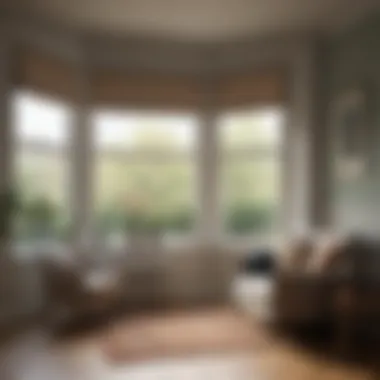Innovative Bay Window Cover Ideas for Any Interior


Intro
Bay windows create unique architectural features in homes, bringing light and depth to an interior space. However, selecting the right covering for these windows can be a challenge. Innovative bay window cover ideas can transform not only how light enters a room but also its aesthetic appeal. Such coverings can help craft a focal point while integrating functionality that matches individual preferences. This article addresses a variety of options suitable for different interiors, focusing on styles, materials, and practical needs that align with contemporary trends.
Design Inspiration
Current Trends in Interior Design
In recent years, several design trends have emerged that highlight the importance of natural light and open spaces, making bay windows even more relevant in modern interiors. Homeowners are increasingly opting for minimalistic and sleek designs that exude simplicity and sophistication.
Key trends include:
- Layered textiles: Mixing sheer fabrics with heavier drapes allows for flexibility in light control and adds an element of texture to the room.
- Roman shades: These provide a clean, classic look while offering practical shading options.
- Natural materials: Wood and bamboo are becoming popular choices, harmonizing with eco-friendly designs.
Color Schemes and Palette Ideas
When choosing coverings for bay windows, the color palette significantly impacts the room's ambiance. Neutral tones like whites, beiges, and greys are staples, allowing for versatility and complementing various furnishings. For a more vibrant approach, consider:
- Bold colors: Deep greys, forest greens, or jewel tones can create a dramatic effect, drawing focus to the bay window.
- Subtle patterns: Light stripes or soft florals can add character without overwhelming the space.
- Contrast: Choosing colors that contrast with wall shades can enhance the bay window's appearance, making it stand out as a design element.
"Balancing aesthetics with functionality is key to selecting the right bay window covering."
Gardening Techniques
Bay windows can serve as an excellent opportunity for both indoor plants and aesthetically pleasing gardening.
Plant Selection and Care
For a vibrant display, consider plants that thrive in bright light. Some suitable options are:
- Herbs: Basil, rosemary, or dill can be practical and beneficial in the kitchen.
- Succulents: Low-maintenance plants like jade or aloe vera enhance a bay window's appeal.
- Ferns: Adding greenery with ferns can soften the edges of hard surfaces.
Each plant has different care requirements, so it is important to understand their needs regarding water, sunlight, and humidity.
Indoor vs. Outdoor Gardening
While some homeowners prefer to use the bay window to nurture indoor plants, others may use the area for outdoor gardening inspiration. If gardening is an interest, consider how the bay window can connect the indoors with the outdoors. Incorporating planters or window boxes can achieve this effect, providing a natural transition while also beautifying the exterior view.
Understanding Bay Windows
Bay windows are a unique architectural feature, offering both aesthetic charm and functional benefits. They not only introduce natural light into a room but also extend the living space and view. This section will explore the vital components that define bay windows, their architectural significance, and the benefits they bring to various interiors.
Definition and Characteristics
A bay window is defined as a protrusion from the main walls of a building, typically consisting of three panels or more that create a sheltered alcove. These windows are commonly designed in a semi-hexagonal or polygonal shape. The angle of the bay can vary, offering different depth and projection away from the house. This design allows for increased light and creates a more open feel within the room.
Bay windows can be made from various materials, including wood, vinyl, and aluminum. Their configuration often includes casement styles or double-hung windows, enhancing both functionality and ventilation.
Common Architectural Styles Featuring Bay Windows
Bay windows can be found in various architectural styles, enriching the character of a home. Some of the notable styles include:
- Victorian: Characterized by intricate detailing, these homes often used bay windows to showcase elaborate facades.
- Georgian: This style incorporates symmetrical designs, often featuring tall bay windows that contribute to their stately appearance.
- Craftsman: Known for simplicity and functionality, these homes use bay windows to create cozy nooks and maximize natural light.
- Modern: Contemporary designs utilize large bay windows with clean lines and expansive glass, promoting minimalism and outdoor views.
Each style offers a unique interpretation of the bay window, making it an essential element in many buildings.
Benefits of Bay Windows
Bay windows provide numerous benefits that enhance the overall livability of a home. Here are several key advantages:
- Increased Natural Light: Bay windows allow more sunlight to enter, which can brighten up even the darkest spaces.
- Wider Views: The projection from the house provides expansive views of the surrounding landscape or garden, enhancing the connection to nature.
- Extra Space: The alcove created by the bay window can serve various purposes, such as a reading nook, plant corner, or additional storage area.
- Aesthetic Appeal: These windows add architectural interest and value to a home, making it stand out in the neighborhood.


"Bay windows are a blend of function and beauty, offering both coziness and style to different interior spaces."
Understanding bay windows is crucial for homeowners and interior design enthusiasts as it informs the selection of appropriate covers and treatment ideas. Recognizing their features and benefits helps in making informed decisions that enhance the functionality and beauty of living spaces.
Key Considerations for Choosing Bay Window Covers
When selecting covers for bay windows, several key considerations must be examined. These factors influence not just the aesthetics of a space but also the functionality and longevity of the chosen coverings. Each element interacts with the others, ensuring a result that is both visually appealing and practical. An informed decision will harmonize the unique architectural feature of bay windows with the overall design ethos of a home.
Functional Requirements
Functional requirements are perhaps the most crucial aspect. Bay windows serve multiple purposes, thus their covers should align with these functions. For instance, privacy can be a prime concern in houses located close to sidewalks or neighboring properties. In such cases, options like blinds or shades that can be easily adjusted provide the necessary solution. Additionally, light control is another functional aspect; sheer fabrics allow natural light while providing some privacy, while blackout options may be favored for bedrooms or media rooms.
Moreover, energy efficiency should not be overlooked. Window coverings like insulated shades can help maintain internal temperatures, contributing to energy savings. The ease of use is also important, especially for larger bay windows. Motorized options or cordless designs might be beneficial to facilitate operation without the hassle of cords.
Aesthetic Cohesion
Aesthetic cohesion plays a vital role in ensuring that bay window covers integrate seamlessly with the existing decor. The design should complement the room’s overall theme. For traditional interiors, lace curtains or wooden shutters may align well, contributing a touch of elegance. Conversely, a modern space could benefit from sleek roller shades or contemporary drapery that emphasize clean lines.
Color remains a significant aspect of aesthetic cohesion. A color palette that complements the surrounding walls and furnishings helps create a harmonious look. It can be beneficial to choose fabrics or materials that echo other elements in the room, such as throw pillows or artwork.
"Choosing the right window coverings can substantially enhance both functionality and beauty in any room."
Material Durability
The durability of the materials chosen for bay window coverings cannot be understated. Bay windows often face varying amounts of sunlight and temperature changes, which can wear down certain materials more quickly than others. For example, real wood blinds offer a classic look but may be susceptible to warping if not properly maintained. On the other hand, synthetic materials such as vinyl or faux wood can withstand humidity and are generally easier to clean.
When considering durability, think also about the cleaning and maintenance needs of the materials. Fabrics like cotton or polyester might require more frequent washing compared to vinyl or wood, which can usually only need a quick wipe down. As bay windows can often be a place for dust accumulation, choosing materials that require less upkeep might save effort in the long term.
In summary, choosing covers for bay windows involves multiple layers of consideration. By evaluating functional requirements, ensuring aesthetic cohesion, and selecting durable materials, homeowners can create a space that reflects both personal style and practical needs.
Material Options for Bay Window Covers
Choosing the right material for bay window covers is critical for both aesthetics and functionality. The materials used will influence light control, insulation, maintenance, and overall design harmony. Discerning homeowners should evaluate various options to find what aligns best with their interior themes and personal requirements. Each material has its unique benefits and considerations, making it essential to understand their characteristics before making a selection.
Drapery Fabrics
Types of Fabrics
Drapery fabrics are a perennial choice for window coverings, as they offer softness and elegance. Options like cotton, linen, polyester, and silk each bring their charm. Cotton is popular for its breathable nature, while linen adds a touch of luxury. Silk provides a sophisticated sheen but may require more maintenance. Each fabric's weight and drape contribute significantly to the overall look.
The versatility of these fabrics allows them to complement a myriad of decor styles. For instance, light-colored cotton can brighten a space, while darker, heavier fabrics create warmth and coziness. The choice depends on not just aesthetic preference but also practical needs like durability and ease of cleaning.
Choosing a Color Palette
The color palette for drapery fabrics dictates the ambiance of a room. Light, neutral tones can create an airy feel, while bold colors can serve as a focal point. A carefully chosen color scheme can unify different elements of a room or create a striking contrast that enhances the overall design.
Colors also affect the perception of space. Lighter shades make small rooms appear larger, while darker tones can make them feel more intimate. It's crucial to consider existing decor, lighting conditions, and personal style when selecting a color palette for your bay window drapes.
Wood and Vinyl Blinds
Advantages of Wood Blinds
Wood blinds naturally bring warmth and elegance to any space. Their classic appeal fits traditional and modern interiors alike. The unique grain of real wood adds character, enhancing the room's overall richness. Additionally, wood has excellent insulating properties, helping to maintain a comfortable temperature indoors.
However, wood blinds need regular maintenance to keep them looking fresh. They are susceptible to moisture, thus not ideal for all environments. Still, their style and functionality make them a highly sought-after choice for many homeowners.
Benefits of Vinyl Options
Vinyl blinds offer a cost-effective and low-maintenance alternative to wood. They come in various colors and styles, allowing for customization based on personal preference. Unlike wood, vinyl is moisture-resistant, making it suitable for kitchens and bathrooms. This durability factor adds to their appeal, especially for family homes.
Despite their benefits, vinyl blinds may lack the warmth that wood provides. However, their practicality and ease of cleaning often outweigh this drawback for many.


Shutters
Types of Shutters
Shutters come in various styles, such as plantation, traditional, and café. Plantation shutters are particularly popular due to their versatility; they can be adjusted easily for light and privacy control. Traditional shutters, with their classic design, can enhance period homes, while café shutters provide a unique solution for enhancing privacy while still allowing light in.
The choice of shutter style depends on personal taste and the specific needs of the room. It is crucial to consider how each type would interact with existing decor and the functionality it will provide.
Custom vs. Standard Fit
Choosing between custom and standard-fit shutters is essential for achieving a seamless look. Custom-fit shutters provide exact measurements, ensuring they fit your bay window perfectly. This precision adds to the overall aesthetic and functionality of the window treatment. However, they may come at a higher price point.
Standard-fit shutters can be a more budget-friendly option. They may require slight adjustments during installation but can still look quite good. The decision comes down to budget considerations and personal preference regarding fit and finish.
Window Film and Shades
Privacy and Sun Control
Window films offer effective solutions for privacy and sun control without blocking natural light. They come in a variety of tints and opacities, allowing for customization based on individual needs. This flexibility helps regulate indoor temperatures and protect furniture from UV damage.
Their minimalist appearance can seamlessly blend with various interior styles, making them an appealing option for many homeowners. However, some may find them less visually appealing compared to more traditional coverings.
Design Versatility
Window shades vary greatly in design, allowing for an effortless integration into any decor theme. From roller shades to roman shades, the design choices are extensive. They can be used alone or in combination with draperies or blinds for a layered look.
The ability to choose from various colors, patterns, and textures makes shades a versatile option for design enthusiasts. However, the choice requires careful consideration of how each style complements existing furnishings and color schemes.
Styles of Bay Window Covers
Selecting the right styles of bay window covers is a significant aspect of enhancing both the functionality and aesthetic appeal of your interiors. Bay windows, with their unique shape and architectural prominence, offer an excellent opportunity for creative design. Window covers can either complement or detract from the character of these architectural features. Hence, understanding various styles is crucial for achieving a harmonious look in your living space.
Different styles of bay window coverings cater to various tastes and practical needs. They allow homeowners to express their personal style while ensuring the windows serve their intended purpose effectively. Among the factors to consider are how light enters the room, the desired level of privacy, and overall decor. Furthermore, styles influence the atmosphere of a room, whether aiming for a cozy retreat or a sophisticated space. This segment will explore contemporary styles, traditional options, and eclectic designs, outlining key characteristics and their benefits.
Contemporary Styles
Contemporary styles of bay window covers focus on clean lines, minimalism, and functionality. Fabrics and materials used tend to be lighter and airy, allowing ample natural light while providing a modern touch. Roller Shades and Sheer Blinds are popular choices in this category. Both options can easily adapt to varying levels of opacity. These styles can create a sleek look without overwhelming the space.
Another strong candidate is Panel Track Blinds. These seamlessly slide open and closed, giving a modern and sophisticated feel. They work well in wide bay windows and provide an easy way to manage sunlight and privacy. Clean colors and geometric patterns often dominate contemporary designs, making them versatile for modern interiors.
Traditional Options
Traditional styles encompass a wide range of designs that reflect classic aesthetics. Such coverings often feature heavier, rich fabrics like velvet or patterned drapes. Curtains or Roman Shades are common picks, adding a touch of elegance and warmth to a bay window.
Layering is a common technique in traditional styles. For instance, sheer curtains can be combined with heavier drapery. This not only enhances texture but also allows homeowners to customize light levels throughout the day. It’s particularly favorable for those who appreciate intricate designs and high-quality materials that echo historical craftsmanship.
Eclectic Designs
Eclectic designs combine various styles, textures, and colors, creating unique visual interest. They break the mold by merging contemporary trends with traditional elements. For instance, combining heavy drapery with modern blinds allows for a playful juxtaposition that feels both refreshing and personal.
This style encourages creativity and self-expression. Homeowners can mix and match bold patterns or colors to reflect their personality. Accessories like decorative hardware or custom-made valances often accentuate these designs. The beauty of eclectic styles lies in their ability to tell a story through various elements, resulting in a genuinely personalized bay window treatment.
Practical Installation Techniques
When it comes to bay window covers, practical installation techniques are essential. Achieving the right fit not only enhances the aesthetics but also improves the overall functionality of the coverings. A poorly fitted cover can lead to light leakage and may not provide adequate privacy or insulation. Therefore, understanding the installation process is key for any homeowner or interior design enthusiast.
Measuring Your Bay Window
Accurate measurements are the foundation of a successful installation. Begin by measuring the width at the top, middle, and bottom of the window. The most narrow measurement should be used to ensure a proper fit. Remember to measure the height as well. If your bay window has a curve, consider measuring the angle between the panes to determine the best type of cover.
This process requires precision. Using a steel tape measure is recommended for accuracy. Additionally, keeping the measuring tool level is crucial to avoid errors.


Mounting Hardware Options
Choosing the right mounting hardware is significant for the longevity and stability of your bay window coverings. Options include:
- Brackets: Available in various sizes and designs, brackets should match the weight of your chosen covering.
- Rods: If using drapery, ensure you select a rod that can accommodate the length and size of the window, and also consider a decorative style if it will be visible.
- Cleats: Useful for tying back drapes or shades, these should be installed at an accessible height.
Each hardware choice should be based on the type of covering selected, as well as the bay window's specific structure. For example, heavier materials like shutters require robust brackets.
Professional Installation vs. DIY
The decision between professional installation and DIY methods hinges on several factors. Cost is often a primary concern; DIY installation can save money, but may lead to errors if one is unfamiliar with the process. Hiring a professional might come with a higher price tag, but it ensures a correct fit and proper technique.
Skill level also plays a role. If a homeowner has experience with tools and installations, DIY may be feasible. However, for those lacking confidence or knowledge, professional assistance may lead to a better outcome.
Finally, consider the time commitment. DIY installations may take longer, while professionals can usually complete the job efficiently.
Maintenance of Bay Window Covers
Maintaining bay window covers is essential for preserving their aesthetic and functional qualities. Regular care not only extends their lifespan but also enhances the comfort and beauty of the living spaces they adorn. Homeowners should understand that maintenance varies based on the materials used for the covers, be it fabrics, wood, or other substances. This section will elaborate on the significance of upkeep and its associated benefits, ensuring that readers grasp the importance of caring for their bay window treatments.
Cleaning Different Materials
The cleaning of bay window covers should be tailored to the specific materials used. Different materials require different care techniques to maintain their appearance and functionality.
- Fabric Drapes: These require regular dusting and vacuuming to keep dust and allergens at bay. For deeper cleaning, it’s advisable to check the care label. Some fabric drapes are machine washable, while others may need dry cleaning.
- Wood Blinds: Wood blinds can be wiped down with a damp cloth to remove dust. It is important to avoid soaking the wood, as excess moisture can warp or damage the finish.
- Vinyl Blinds: Cleaning vinyl is simpler; a mild soap solution and a soft cloth can effectively remove stains and grime.
- Shutters: Depending on whether they are made from wood or composite materials, these should be dusted regularly and cleaned with a solution appropriate for the material.
Effectively cleaning your window coverings not only keeps them looking new but also increases the longevity of the product.
Inspection and Repair Tips
Regular inspection of bay window covers helps identify wear and tear before they become significant issues. This proactive approach can save homeowners from expensive repairs or replacements down the line.
- Look for Damage: Check for fraying or tears in fabric and cracks in wood. If you find any issues, address them promptly to prevent further damage.
- Check Mounting Hardware: Ensure that brackets and other mounting hardware are secure. Loose fittings can lead to uneven hanging or, in worst-case scenarios, the complete failure of the cover.
- Repair Options: Many minor issues can be fixed at home. For instance, frayed fabric can sometimes be stitched, while small dents in wood can often be filled with wood filler and re-stained.
By incorporating a regular inspection schedule, you can enhance the durability of your bay window coverings and ensure that they continue to contribute to your home's interior harmony.
"Maintaining bay window covers is not just about aesthetics; it's a matter of comfort and functionality that heightens the overall living experience."
Properly managing the care and maintenance of bay window covers will yield significant benefits. Homeowners should prioritize cleaning and inspections, ensuring their windows remain a point of beauty in their homes.
Innovative trends in Bay Window Coverings
In today’s ever-evolving design landscape, bay window coverings must blend functionality with aesthetic appeal. Innovative trends draw on technology and sustainability while addressing the unique needs of homeowners and design enthusiasts. These trends not only enhance the visual dynamics of a room but also introduce conveniences that cater to modern living.
Smart Home Integration
The integration of smart technology into home design is reshaping the way we approach window coverings. Smart home systems now allow for real-time control over bay window covers, providing convenience and enhancing energy efficiency. Homeowners can automate the opening and closing of shades or blinds based on the time of day or ambient light levels.
Benefits of Smart Integration:
- Convenience: Users can control their window coverings using a smartphone or voice command through devices like Amazon Alexa or Google Assistant.
- Energy Savings: Automated systems can optimize the use of natural light, reducing reliance on artificial lighting and minimizing heating costs during colder months.
- Enhanced Privacy: With programmable settings, homeowners can ensure their privacy is maintained without the need for constant manual adjustments.
In addition, smart sensors can adjust coverings based on temperature readings, providing an additional layer of comfort. As the trend towards smart homes grows, the expectations for bay window coverings follow suit, ensuring that they suit a tech-savvy audience.
Sustainable Materials
The increasing awareness regarding environmental issues is influencing choices in interior design. Homeowners are now paying closer attention to the materials used in bay window coverings. The trend is shifting towards sustainable materials that minimize ecological impact while still offering adequate functionality and style.
Popular Sustainable Options:
- Bamboo Shades: Strong, lightweight, and renewable, bamboo is one of the most sustainable choices for window coverings.
- Recycled Fabrics: Many manufacturers now offer fabrics made from recycled materials, providing a chic option without harming the planet.
- Natural Fibers: Materials like cotton and linen are biodegradable and can be sourced sustainably. These fabrics bring a softer touch to the interiors.
Opting for sustainable materials not only supports eco-friendly practices but can also enhance indoor air quality. Non-toxic dyes used in the production process can contribute to a healthier living environment.
“Selecting sustainable materials for bay window coverings allows homeowners to make a statement about environmental responsibility while enhancing the aesthetics of their space.”
These innovative trends in bay window coverings illustrate a shift towards more thoughtful design choices. They serve both practical needs and aesthetic desires, catering to a discerning audience that values technology and sustainability in their living spaces.



